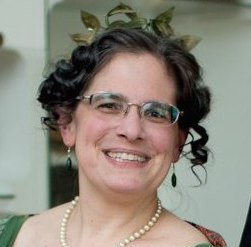- Era: 1910s
The half and half, a hesitation waltz danced in 5/4 time, was one of those novelties that appeared and vanished quickly in 1914. There may be as many people alive now who know how to dance it as ever danced it in its own era! It is also handicapped by having very few surviving pieces of music in the right time signature. Today’s experienced historical social dancers can probably hum the eponymous “Half and Half” from memory. Sources describing the dance are equally difficult to come by; I have only three in my collection, though one of them, Dance Mad, generously provides four separate descriptions.
Click here to listen to a half and half tune in 5/4 time.
The essence of the half and half pattern is to make three steps over five counts of music, moving on counts one, four, and five. The effect is “slooooow, quick-quick, slooooow, quick-quick.” Vernon and Irene Castle helpfully state that “all the modern Waltz or Hesitation steps fit in delightfully after one has caught the rhythm.” For those who would like a bit more detail, here are four basic steps to use in the half and half.
– Backing the lady. Assuming waltz position, gentleman starting left foot forward and lady right foot backward, take one long step along the line of dance, holding through counts 1-2-3, then take two quick shorter steps, 4-5. Repeat on the opposite foot. All three are distinct steps along the line of dance, not “step, step-close” or (worse yet) “step, close-step”. The step is enhanced if one rises slightly on the toes on the first step, leaving the trailing leg gently extended behind, toe touching or just off the ground. The motion should be light, poised to move onward quickly with the music, rather than plodding.
Presumably one could also back the gentleman.
– Promenading. There are four different descriptions of the half and half in the 1914 compilation, Dance Mad. One, attributed to “Quinlan Twins”, starts the dance with the dancers in waltz position but turned so that both face line of dance. As they make the first (long) step, the back leg is elevated in fourth position behind. Be careful to keep the torso upright when executing this – it should be a beautifully curved line from neck to ankle, not a straight line with the torso parallel to the floor! As with the above move, the step sequence is “step, step-step”, with all steps moving along the line of dance rather than closing the feet on the last.
– Waltzing. The “new” waltz used from the 1880s onward into the 1910s (later developing into the modern waltz and Viennese waltz) fits beautifully into half and half. The first long step is along the line of dance, followed by a quick “slide-close” to complete each half-turn. For a natural (right/clockwise) turn, the gentleman should step backward left to begin; for a reverse (left/counter-clockwise turn), backward right. It is particularly graceful to to carry the free foot through the air (though not too far off the ground) during the first step, turning slowly into position for the last two steps.
– Waltzing Forward/Backward, or the Pursuit. I’m using the terms from Gilbert (1890) and Dodworth (1885) respectively for using the waltz step sequence (step, step-close) to back either the lady or gentleman along the line of dance. This is typically used as the transition from a natural to a reverse turning motion, but it is a more pleasing movement than simply backing the lady (or gent) as described above and can be repeated more times without becoming tedious to the dancer moving backward. The difference between the pursuit and simply backing the lady lies in the step sequence; in the latter, all three steps are straight along the line of dance (step, step-step). In the pursuit, the sequence is step-step-close, and the last two steps (counts 4 and 5 in the half and half) should be taken at a slight diagonal angle along the line of dance so that the final close may be a gentle sideways bringing-together of the feet. This is both easier to lead and follow than an attempt to “step-close” straight along the line of dance and more graceful in general.
A follow-up post at some point in the future will address more complex variations for the half and half, but these four moves are enough to glide gracefully through the dance, should one have the rare opportunity to do so.
Sources for music:
The tune “Half and Half” is available on the lovely CD Now Tango from Spare Parts, available for order here.
The only other recording I have found (and it appears to be the same tune) is “Francine” on the Mont Alto Motion Picture Orchestra CD Notoriety, which may be purchased here. There’s also a downloadable mp3 there if you’re cheap. This recording is slightly slow and has a lengthy introduction; I trimmed it with editing software for dance purposes.
Period sources for the half and half:
Modern Dancing, by Vernon and Irene Castle, New York, 1914.
Dance Mad, [edited] by F. Leslie Clendenen, St. Louis, 1914


Leave a Reply